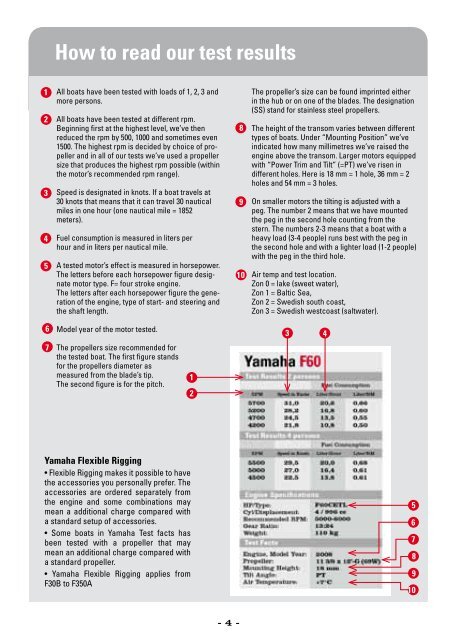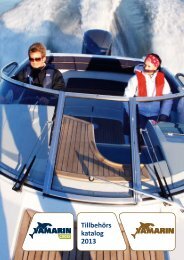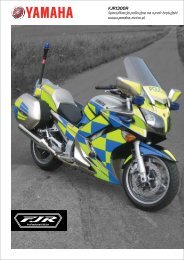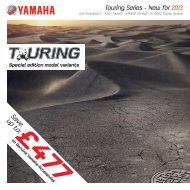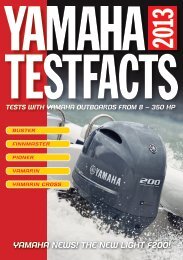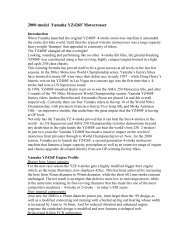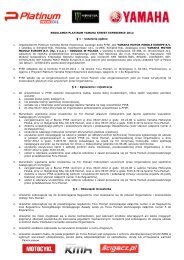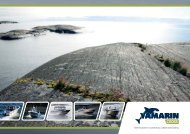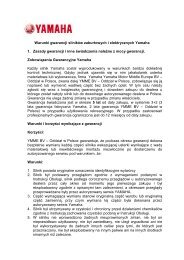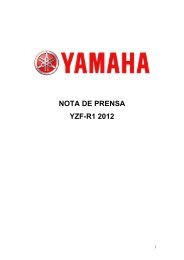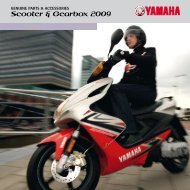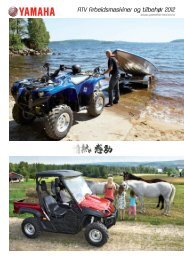Yamaha F100 Yamaha F70 - Yamaha Motor Europe
Yamaha F100 Yamaha F70 - Yamaha Motor Europe
Yamaha F100 Yamaha F70 - Yamaha Motor Europe
You also want an ePaper? Increase the reach of your titles
YUMPU automatically turns print PDFs into web optimized ePapers that Google loves.
1<br />
2<br />
3<br />
4<br />
5<br />
6<br />
7<br />
How to read our test results<br />
All boats have been tested with loads of 1, 2, 3 and<br />
more persons.<br />
All boats have been tested at different rpm.<br />
Beginning first at the highest level, we’ve then<br />
reduced the rpm by 500, 1000 and sometimes even<br />
1500. The highest rpm is decided by choice of propeller<br />
and in all of our tests we’ve used a propeller<br />
size that produces the highest rpm possible (within<br />
the motor’s recommended rpm range).<br />
Speed is designated in knots. If a boat travels at<br />
30 knots that means that it can travel 30 nautical<br />
miles in one hour (one nautical mile = 1852<br />
meters).<br />
Fuel consumption is measured in liters per<br />
hour and in liters per nautical mile.<br />
A tested motor’s effect is measured in horsepower.<br />
The letters before each horsepower figure designate<br />
motor type. F= four stroke engine.<br />
The letters after each horsepower figure the generation<br />
of the engine, type of start- and steering and<br />
the shaft length.<br />
Model year of the motor tested.<br />
The propellers size recommended for<br />
the tested boat. The first figure stands<br />
for the propellers diameter as<br />
measured from the blade’s tip.<br />
The second figure is for the pitch.<br />
<strong>Yamaha</strong> Flexible Rigging<br />
• Flexible Rigging makes it possible to have<br />
the accessories you personally prefer. The<br />
accessories are ordered separately from<br />
the engine and some combinations may<br />
mean a additional charge compared with<br />
a standard setup of accessories.<br />
• Some boats in <strong>Yamaha</strong> Test facts has<br />
been tested with a propeller that may<br />
mean an additional charge compared with<br />
a standard propeller.<br />
• <strong>Yamaha</strong> Flexible Rigging applies from<br />
F30B to F350A<br />
1<br />
2<br />
8<br />
9<br />
10<br />
- 4 -<br />
The propeller’s size can be found imprinted either<br />
in the hub or on one of the blades. The designation<br />
(SS) stand for stainless steel propellers.<br />
The height of the transom varies between different<br />
types of boats. Under “Mounting Position” we’ve<br />
indicated how many millimetres we’ve raised the<br />
engine above the transom. Larger motors equipped<br />
with “Power Trim and Tilt” (=PT) we’ve risen in<br />
different holes. Here is 18 mm = 1 hole, 36 mm = 2<br />
holes and 54 mm = 3 holes.<br />
On smaller motors the tilting is adjusted with a<br />
peg. The number 2 means that we have mounted<br />
the peg in the second hole counting from the<br />
stern. The numbers 2-3 means that a boat with a<br />
heavy load (3-4 people) runs best with the peg in<br />
the second hole and with a lighter load (1-2 people)<br />
with the peg in the third hole.<br />
Air temp and test location.<br />
Zon 0 = lake (sweet water),<br />
Zon 1 = Baltic Sea,<br />
Zon 2 = Swedish south coast,<br />
Zon 3 = Swedish westcoast (saltwater).<br />
3 4<br />
5<br />
6<br />
7<br />
8<br />
9<br />
10


